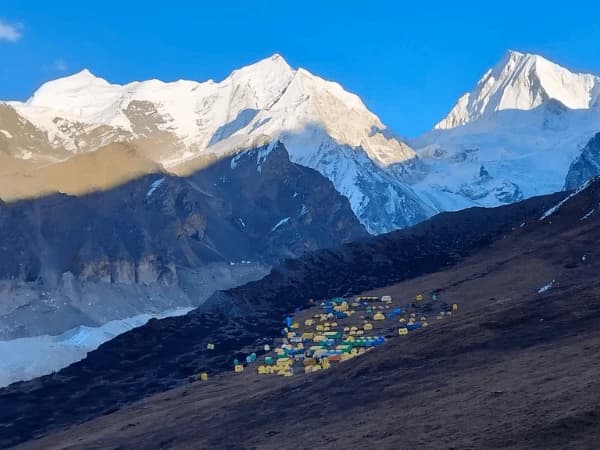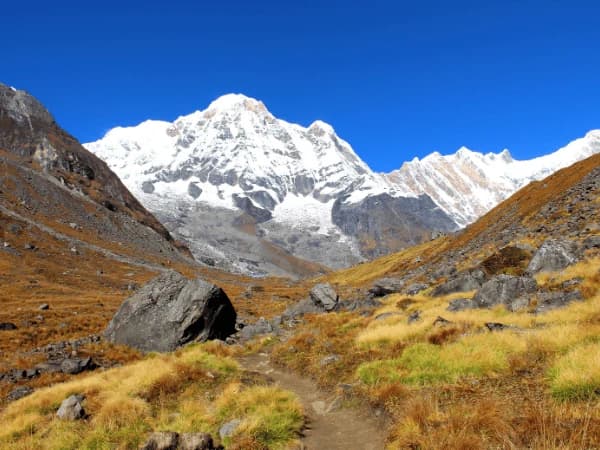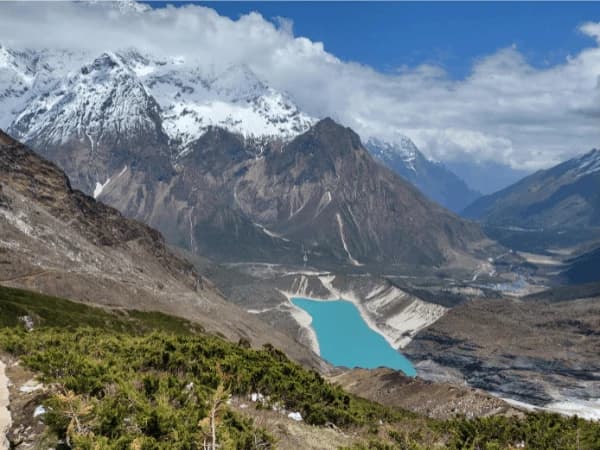Lobuche Peak Preparation Overview
Embarking on a Lobuche Peak climbing adventure in the Everest region is a thrilling challenge for any peak enthusiast. Lobuche Peak East (6,119m) towers above the Khumbu, promising stunning Himalayan panoramas from Everest to Lhotse. To succeed, climbers need thorough peak climbing preparation. That’s why in this blog, we have all the answers on how to prepare for the Lobuche Peak Climb.

This means understanding the terrain, training your body, packing the right gear, and acclimatizing smartly. Whether you’re dreaming of Lobuche Base Camp at 4,900m or the final snowy ridges, careful planning is key. In this guide, we’ll break down experience requirements, gear lists, fitness tips, season selection, technical skills, and more to help you scale Lobuche Peak safely and confidently. The trail to Lobuche Peak traverses high alpine valleys beneath the snow-capped Himalayas. Proper training and pacing on such rugged terrain are essential for summit success.
Do I Need Prior Experience for Lobuche Peak?
Lobuche East is technically a trekking peak, but it’s more challenging than a simple hike. As one guide notes, “Lobuche Peak is an approachable yet challenging climb”. In practice, this means that while novices can attempt Lobuche East, it helps immensely to have prior high-altitude trekking or mountaineering experience. The summit push involves steep ice and snow, fixed ropes, and glacier crossings, so basic mountaineering skills are important. Overland Trek Nepal recommends that climbers be in excellent health and have completed at least one other high-altitude trek or have done a basic climbing course.
Lobuche East vs. West: Remember, Lobuche has two summits. Lobuche West (6,145m) is a full expedition peak with highly technical routes, while Lobuche East (6,119m) is the “trekking peak.” Lobuche East is considered non-technical and more accessible – Overland Trek Nepal even describes it as a “beginner-friendly … non-technical expedition perfect for novice climbers”. However, “beginner-friendly” doesn’t mean “easy” – you’ll still scramble on rocky ridges and use ropes.
Altitude Acclimatization: Even experienced trekkers must respect altitude. The climb goes above 6,000 meters, so prior experience with altitude is crucial. Those with no high-altitude background should spend extra acclimatization days (often via the Everest Base Camp trek) before attempting the summit. In our Lobuche Peak Climbing Itinerary, we have managed a few days for acclimatization.
Guided Teams: If it’s your first big climb, go with a reputable guide service. Guides handle logistics, route-finding, and safety. Our experienced Shera Guide from Overland Trek Nepal will assist you in summitting this peak successfully. They’ll also give on-the-spot coaching on rope and crampon techniques. In short, while beginners can climb Lobuche East, it’s safest (and more enjoyable) if you have at least some prior trekking or mountaineering background.
What Gear Do I Need to Summit Lobuche East?
Climbing Lobuche East requires a full set of mountaineering equipment. In practice, you’ll need both trekking and climbing gear:
- Mountaineering Boots: Sturdy, insulated 4-season mountaineering boots compatible with crampons. These keep your feet warm and stable on ice and snow.
- Crampons & Ice Axe: A 12-point steel crampon for ice, and a rigid mountaineering ice axe. These are essential for the steep summit ridge.
- Harness, Helmet, and Ropes: A climbing harness, locking carabiners, slings/cords, and a helmet. Lobuche’s final sections have fixed ropes, so you’ll clip in for safety.
- Warm Clothing: Layered clothing is a must. This includes moisture-wicking base layers, fleece/mid-layers, and a high-quality down jacket and down pants for summit nights. Windproof/waterproof shell jacket and pants are also required.
- Gloves, Hats, and Sunglasses: Bring multiple layers of gloves (liners, warm mittens) and a sun hat plus a warm beanie. Glacier sunglasses or goggles with UV protection are crucial for the high glare.
- Sleeping Bag: A sleeping bag rated to at least –20°C (some guides prefer –30°C). Nights above 5,000 meters get very cold.
- Backpack (50–60 L): A sturdy pack with external attachments for your ice axe and crampons. Compression straps are handy for cinching down the load.
- Trekking Gear: Daypack (20–30L) for essentials during hikes, trekking poles, water bottles or hydration system, a headlamp, sunscreen, and personal first-aid.
- Optional Gear: Many climbers also carry an alpine bivy sack or lightweight tent in case of emergency, and personal hiking gaiters.
Every climber carries a backpack of essential gear as they hike toward high camps. Proper equipment (boots, crampons, helmet, ice axe, harness, warm layers) is non-negotiable for Lobuche’s snowy summit ridge.
Note: Remember, you can also hire climbing Gear at Lobuche if you don’t have personal gear.
Physical Fitness for the Lobuche Climb
Lobuche Peak requires excellent fitness and endurance. The climb and its approach involve long days of hiking at altitude, often 6–10 hours per day. You should have:
- Aerobic Endurance: Train with long hikes (6–8 hours) carrying a backpack. Practice on steep trails to simulate mountain conditions. Cardiovascular workouts (running, cycling, stair-climbing, swimming) help build lung capacity.
- Leg and Core Strength: Strong legs are crucial for all that up-and-down hiking. Include squats, lunges, and step-ups in your workouts. Core stability exercises (planks, balance drills) help with heavy backpacking and climbing balance.
- High-Altitude Acclimatization: If possible, do treks or climbs reaching 4,000–5,000 meters beforehand. Your body adapts better if you expose it to thinner air on training hikes.
- Stamina: The final summit push can be 10+ hours on very little sleep. Train with back-to-back long days of exercise. Trail runs, overnight hut-to-hut treks, and carrying weight up hills are good preparations.
- Rest and Recovery: Include rest days in your fitness plan. Your muscles need recovery from intense workouts, just as climbers need rest days on the trail.
Regular training in the months before your trip will make a huge difference. Good conditioning also helps reduce the risk of altitude sickness. In fact, “being fit lowers the risk of altitude sickness”. In short, think of the Lobuche climb as a marathon at altitude – proper training is peak climbing preparation.
Choosing the Best Time to Climb Lobuche Peak
Timing your expedition is crucial. Climbing seasons in the Himalaya hinge on weather stability:
Autumn (Sept–Nov): This is the most popular season. Monsoon rains have ended, the air is crisp, and mountain views are outstanding. Days are generally clear. Nights are cold but bearable. According to trekking guides, “September to November… the weather is usually plain and dry throughout this season, with little chance of rain or snow”. Note: Everest area autumn nights get as cold as –15°C or lower at high camps, so pack accordingly.
Spring (Mar–May): This is the other prime season. Snow from winter starts melting, rhododendrons bloom in the lower regions, and trails open up. Early spring (March–April) can have crisp weather and gradually warming days. Hillary Step Treks notes spring weather is “generally warmer and more stable than in the winter”. By May, some afternoon cloud or occasional showers may appear as the pre-monsoon heat builds.
In summary, aim for Autumn or Spring. Many climbers combine Lobuche with the classic Everest Base Camp trek in these months. Even then, always leave wiggle room for weather delays. As one source advises, choose seasons for “stable weather conditions” and plan acclimatization days to limit altitude sickness risk.
Technical Skills to Know for the Lobuche Peak
Though Lobuche East is a “trekking peak,” the summit ridge involves technical movement. Key skills include:
- Fixed Rope and Ascending: Parts of the final climb use fixed ropes anchored into the snow/ice. You should be comfortable clipping into a fixed line with a daisy chain or cow’s tail, and using ascenders (jumars) on the rope if needed. Practice on indoor climbing walls or glacier training courses.
- Crampon Technique: Walking on steep icy slopes in crampons takes balance. Practice flat and steep ice slopes to get used to kick-stepping and flat-footing. Be sure you can attach crampons to your boots quickly (even while wearing gloves).
- Ice Axe Self-Arrest: Even if the climb uses fixed ropes, you must know how to use an ice axe to stop a fall. Practice controlled falls with self-arrest techniques on gentle snowy hills.
- Rock Scrambling: Lobuche’s summit ridge includes rocky terrain. You should be confident scrambling over boulders in boot-crampon combos.
- Team Rope Travel: If climbing with a rope team, you should know basic belaying, rope management, and glacier travel (even though Lobuche’s glacier is straightforward, basic crevasse rescue knowledge is a plus).
- Glacier Travel Skills: The approach to Lobuche involves walking on loose moraine and possibly a glacier section near Lobuche Base Camp. Knowing how to cross crevassed terrain and step over irregular ice/snow is helpful.
Overland Trek Nepal operates a training session at Lobuche Base Camp or High Camp. Additionally, Climbers stress that “Lobuche East requires technical mountaineering skills due to its steep sections of snow, ice, and rock”. If possible, take a beginner mountaineering course or at least practice on smaller peaks (Island Peak Climbing is often recommended before Lobuche). The more proficient you are with technical gear, the safer and more confident you’ll feel on summit day.
Training and skill practice are critical on Lobuche. Fixed ropes, steep snow slopes, and the Khumbu glacier demand that climbers know how to use crampons and ice axes. Proper technique in these conditions can be the difference between a safe ascent and a serious risk.
FAQs
How difficult is Lobuche Peak climbing?
Lobuche East is generally described as moderate to challenging. It’s harder than the typical trek but easier than full expedition peaks. The climb includes steep snow/ice slopes (up to 45–50°) and some exposed sections. “Lobuche Peak climbing is moderately challenging… although the climb is exciting, it can be tough for beginners”. Good fitness, acclimatization, and basic climbing skills make it attainable. Lobuche West is more technical and higher; we focus on Lobuche East here.
What permits are required for the Lobuche Peak Climbing?
You need several permits:
Sagarmatha National Park Permit (US$30) – required for the Everest region.
Pasang Lhamu (Khumbu) Rural Municipality Permit (US$20) – sometimes called the Khumbu Pasang Lhamu license.
Lobuche Peak Climbing Permit (NMA Permit) – issued by the Nepal Mountaineering Association. Costs vary by season (around US$125 in autumn, US$250 in spring).
Overland Trek Nepal helps in arranging these permits and documents before the climb.
What about altitude sickness on Lobuche Peak?
Altitude is the biggest challenge. Lobuche East is 6,119m, and by summit day you’re above 5,000m for several days. Common AMS symptoms are headache, nausea, dizziness, and fatigue. To minimize risk: acclimatize slowly (overnight stops up and down in elevation), drink lots of water, and eat well. Most itineraries include rest days in Namche Bazaar and Dingboche for acclimatization. Guides carry Diamox (acetazolamide) for prevention or treatment if needed. Pay attention to your body – descent at the first signs of serious AMS. Remember, no summit is worth a life; safe acclimatization is part of preparation.
Is a guide or sherpa necessary?
For Lobuche East, having an experienced guide is highly recommended, especially if it’s your first Himalayan climb. A guide arranges logistics (teahouse bookings, food), leads on route-finding, and provides emotional support. Sherpas or porters can carry heavy gear (typically you carry only a daypack). Even seasoned climbers often hire local experts. Using a company like Overland Trek Nepal means permits and logistics are handled for you, and you climb with trained professionals familiar with altitude and rescues. Ultimately, a guide isn’t legally required, but it greatly improves safety and success odds.
How long does the Lobuche Peak Climb take?
A typical Lobuche East expedition lasts 15–20 days, often including the Everest Base Camp trek. For example, an 18-day itinerary might have 2 weeks of trekking plus 3–4 days of technical climbing. Daily hiking before the climb is usually 5–7 hours. Summit day itself can be 10+ hours from High Camp. Plan for about 3 weeks total, including buffer days.
What about Lobuche Base Camp?
Lobuche Base Camp sits at about 4,900 meters in the valley below the Peak. It’s usually reached after EBC, Gorak Shep, and a dip to Pangboche. The base camp is a rocky plateau with stunning views of Ama Dablam and the massif to the west. Teams often camp or stay in tents here before heading to “High Camp” for the summit push. Base Camp is also where many groups do gear checks and final acclimatization. Remember, even at Base Camp, altitude is high – treat it as another acclimatization step, not a rest spot.
How can I best prepare for the Lobuche Peak Expedition?
Start training months ahead (hiking, cardio, altitude if possible). Learn basic rope and ice techniques (many offer weekend clinics). Plan your gear meticulously (don’t skimp on boots or jackets). Arrange a good support team – hiring a guide/trek company will handle permits and safety. Check weather trends and book in peak season (spring or autumn). And, most importantly, go early on summit day – Lobuche’s ridges can be icy by midday. With solid peak climbing preparation, you’ll face Lobuche’s challenges with confidence.
Conclusion
Climbing Lobuche Peak East is a breathtaking adventure that rewards preparation. By building your fitness, mastering basic alpine skills, packing proper gear, and acclimatizing carefully, you turn this daunting climb into an achievable goal. It helps to trek first to Everest Base Camp or Kala Patthar to acclimate, then push on to Lobuche Base Camp and High Camp. Remember that altitude sickness is real on Lobuche Peak; heed its warning signs and let your acclimatization schedule guide you.
An experienced local trekking and climbing operator can make all the difference. Overland Trek Nepal offers guided 18-day Lobuche Peak climbs that include all permits, teahouse logistics, and expert Sherpa support. Our Itinerary combines stunning Khumbu trail scenery (Lobuche Base Camp, Everest vistas) with the summit push, ensuring you don’t need to figure out the details yourself. Get more details about how to prepare for the Lobuche Peak Climb via email or WhatsApp at +9779851138871.





